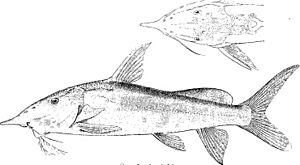Synodontis greshoffi facts for kids
Quick facts for kids Synodontis greshoffi |
|
|---|---|
 |
|
| Conservation status | |
| Scientific classification | |
| Genus: |
Synodontis
|
| Species: |
greshoffi
|
The Greshoff's Upside-Down Catfish (Synodontis greshoffi) is a unique type of catfish. It lives in the Congo Basin in countries like Cameroon, the Democratic Republic of the Congo, and the Republic of the Congo. This fish was first found by M.A. Greshoff in a place called Pool Malebo on the Congo River. A Belgian fish expert named Louise Schilthuis officially described it in 1891, naming it after Mr. Greshoff.
Contents
Discover the Greshoff's Upside-Down Catfish
This special catfish has a cream-colored body. It features brown to golden markings on its sides, which also continue underneath. The patterns become more detailed on its head. Its fins are clear, but they have brown spots.
Unique Features of This Catfish
Like other fish in its group, the Greshoff's Upside-Down Catfish has a bony spike called a humeral process. This spike is connected to a hard cap on its head and can be seen sticking out past its gill opening. The first ray, or "spine," of its dorsal fin (the one on its back) and its pectoral fins (the ones on its sides) are hard and have jagged edges.
Its tail fin is deeply forked, like a "V" shape, with a longer part on the top. This fish has small, cone-shaped teeth in its upper jaw. In its lower jaw, the teeth are S-shaped and can move. It also has one pair of whiskers, called maxillary barbels, near its mouth. Plus, it has two pairs of whiskers, called mandibular barbels, under its chin, which are often branched.
How Big Do They Get?
The Greshoff's Upside-Down Catfish can grow to about 23 centimetres (9.1 in) long, measured from its snout to the base of its tail. However, some have been found in the wild that are even bigger, up to 26.6 centimetres (10.5 in) long in total.
Where the Greshoff's Catfish Lives
In the wild, this species prefers warm, tropical waters. The water temperature usually ranges from 23 to 27 °C (73 to 81 °F). You can find it in the lower and middle parts of the Congo River basin. It also lives in the upper Congo River basin, but not in the Luapula River or Lake Mweru. This catfish has also been seen in parts of the Boumba River and the Doumé River in southern Cameroon.


